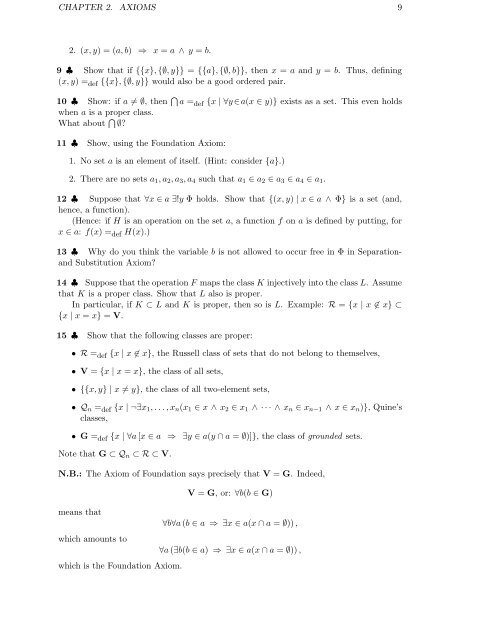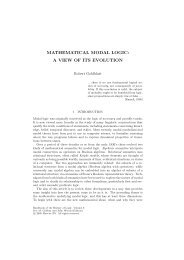Zermelo-Fraenkel Set Theory
Zermelo-Fraenkel Set Theory
Zermelo-Fraenkel Set Theory
Create successful ePaper yourself
Turn your PDF publications into a flip-book with our unique Google optimized e-Paper software.
CHAPTER 2. AXIOMS 9<br />
2. (x, y) = (a, b) ⇒ x = a ∧ y = b.<br />
9 ♣ Show that if {{x}, {∅, y}} = {{a}, {∅, b}}, then x = a and y = b. Thus, defining<br />
(x, y) = def {{x}, {∅, y}} would also be a good ordered pair.<br />
10 ♣ Show: if a ≠ ∅, then ⋂ a = def {x | ∀y ∈a(x ∈ y)} exists as a set. This even holds<br />
when a is a proper class.<br />
What about ⋂ ∅?<br />
11 ♣ Show, using the Foundation Axiom:<br />
1. No set a is an element of itself. (Hint: consider {a}.)<br />
2. There are no sets a 1 , a 2 , a 3 , a 4 such that a 1 ∈ a 2 ∈ a 3 ∈ a 4 ∈ a 1 .<br />
12 ♣ Suppose that ∀x ∈ a ∃!y Φ holds. Show that {(x, y) | x ∈ a ∧ Φ} is a set (and,<br />
hence, a function).<br />
(Hence: if H is an operation on the set a, a function f on a is defined by putting, for<br />
x ∈ a: f(x) = def H(x).)<br />
13 ♣ Why do you think the variable b is not allowed to occur free in Φ in Separationand<br />
Substitution Axiom?<br />
14 ♣ Suppose that the operation F maps the class K injectively into the class L. Assume<br />
that K is a proper class. Show that L also is proper.<br />
In particular, if K ⊂ L and K is proper, then so is L. Example: R = {x | x ∉ x} ⊂<br />
{x | x = x} = V.<br />
15 ♣ Show that the following classes are proper:<br />
• R = def {x | x ∉ x}, the Russell class of sets that do not belong to themselves,<br />
• V = {x | x = x}, the class of all sets,<br />
• {{x, y} | x ≠ y}, the class of all two-element sets,<br />
• Q n = def {x | ¬∃x 1 , . . . , x n (x 1 ∈ x ∧ x 2 ∈ x 1 ∧ · · · ∧ x n ∈ x n−1 ∧ x ∈ x n )}, Quine’s<br />
classes,<br />
• G = def {x | ∀a [x ∈ a ⇒ ∃y ∈ a(y ∩ a = ∅)]}, the class of grounded sets.<br />
Note that G ⊂ Q n ⊂ R ⊂ V.<br />
N.B.: The Axiom of Foundation says precisely that V = G. Indeed,<br />
means that<br />
which amounts to<br />
which is the Foundation Axiom.<br />
V = G, or: ∀b(b ∈ G)<br />
∀b∀a (b ∈ a ⇒ ∃x ∈ a(x ∩ a = ∅)) ,<br />
∀a (∃b(b ∈ a) ⇒ ∃x ∈ a(x ∩ a = ∅)) ,

















